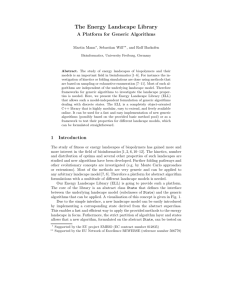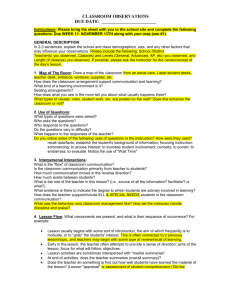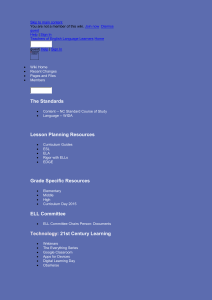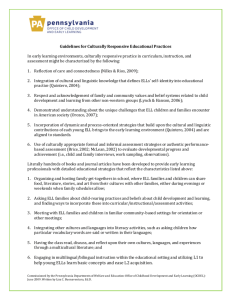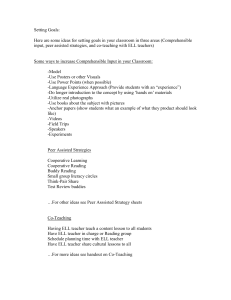The Energy Landscape Library -a Platform for Generic Algorithms
advertisement
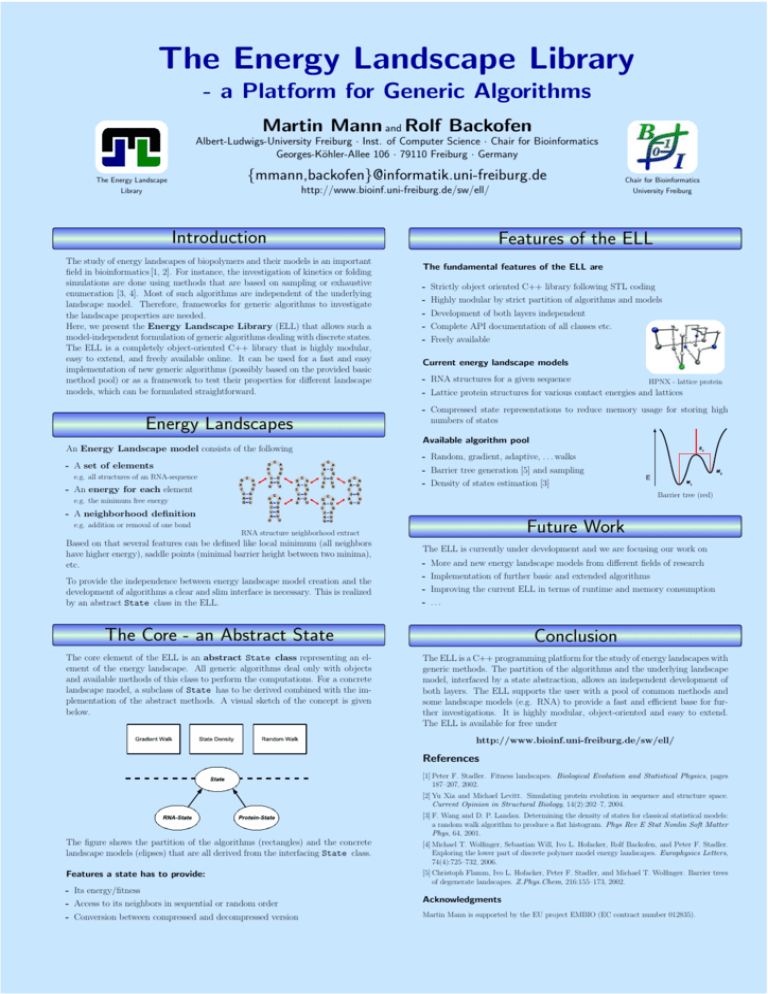
The Energy Landscape Library
- a Platform for Generic Algorithms
Martin Mann
Rolf Backofen
and
Albert-Ludwigs-University Freiburg · Inst. of Computer Science · Chair for Bioinformatics
Georges-Köhler-Allee 106 · 79110 Freiburg · Germany
{mmann,backofen}@informatik.uni-freiburg.de
The Energy Landscape
Library
http://www.bioinf.uni-freiburg.de/sw/ell/
Introduction
The study of energy landscapes of biopolymers and their models is an important
field in bioinformatics [1, 2]. For instance, the investigation of kinetics or folding
simulations are done using methods that are based on sampling or exhaustive
enumeration [3, 4]. Most of such algorithms are independent of the underlying
landscape model. Therefore, frameworks for generic algorithms to investigate
the landscape properties are needed.
Here, we present the Energy Landscape Library (ELL) that allows such a
model-independent formulation of generic algorithms dealing with discrete states.
The ELL is a completely object-oriented C++ library that is highly modular,
easy to extend, and freely available online. It can be used for a fast and easy
implementation of new generic algorithms (possibly based on the provided basic
method pool) or as a framework to test their properties for different landscape
models, which can be formulated straightforward.
Energy Landscapes
An Energy Landscape model consists of the following
- A set of elements
Chair for Bioinformatics
University Freiburg
Features of the ELL
The fundamental features of the ELL are
- Strictly object oriented C++ library following STL coding
- Highly modular by strict partition of algorithms and models
- Development of both layers independent
- Complete API documentation of all classes etc.
- Freely available
Current energy landscape models
- RNA structures for a given sequence
HPNX - lattice protein
- Lattice protein structures for various contact energies and lattices
- Compressed state representations to reduce memory usage for storing high
numbers of states
Available algorithm pool
- Random, gradient, adaptive, . . . walks
- Barrier tree generation [5] and sampling
e.g. all structures of an RNA-sequence
- Density of states estimation [3]
- An energy for each element
Barrier tree (red)
e.g. the minimum free energy
- A neighborhood definition
Future Work
e.g. addition or removal of one bond
RNA structure neighborhood extract
Based on that several features can be defined like local minimum (all neighbors
have higher energy), saddle points (minimal barrier height between two minima),
etc.
To provide the independence between energy landscape model creation and the
development of algorithms a clear and slim interface is necessary. This is realized
by an abstract State class in the ELL.
The ELL is currently under development and we are focusing our work on
- More and new energy landscape models from different fields of research
- Implementation of further basic and extended algorithms
- Improving the current ELL in terms of runtime and memory consumption
- ...
The Core - an Abstract State
Conclusion
The core element of the ELL is an abstract State class representing an element of the energy landscape. All generic algorithms deal only with objects
and available methods of this class to perform the computations. For a concrete
landscape model, a subclass of State has to be derived combined with the implementation of the abstract methods. A visual sketch of the concept is given
below.
The ELL is a C++ programming platform for the study of energy landscapes with
generic methods. The partition of the algorithms and the underlying landscape
model, interfaced by a state abstraction, allows an independent development of
both layers. The ELL supports the user with a pool of common methods and
some landscape models (e.g. RNA) to provide a fast and efficient base for further investigations. It is highly modular, object-oriented and easy to extend.
The ELL is available for free under
http://www.bioinf.uni-freiburg.de/sw/ell/
References
[1] Peter F. Stadler. Fitness landscapes. Biological Evolution and Statistical Physics, pages
187–207, 2002.
[2] Yu Xia and Michael Levitt. Simulating protein evolution in sequence and structure space.
Current Opinion in Structural Biology, 14(2):202–7, 2004.
[3] F. Wang and D. P. Landau. Determining the density of states for classical statistical models:
a random walk algorithm to produce a flat histogram. Phys Rev E Stat Nonlin Soft Matter
Phys, 64, 2001.
The figure shows the partition of the algorithms (rectangles) and the concrete
landscape models (elipses) that are all derived from the interfacing State class.
[4] Michael T. Wolfinger, Sebastian Will, Ivo L. Hofacker, Rolf Backofen, and Peter F. Stadler.
Exploring the lower part of discrete polymer model energy landscapes. Europhysics Letters,
74(4):725–732, 2006.
Features a state has to provide:
[5] Christoph Flamm, Ivo L. Hofacker, Peter F. Stadler, and Michael T. Wolfinger. Barrier trees
of degenerate landscapes. Z.Phys.Chem, 216:155–173, 2002.
- Its energy/fitness
- Access to its neighbors in sequential or random order
- Conversion between compressed and decompressed version
Acknowledgments
Martin Mann is supported by the EU project EMBIO (EC contract number 012835).
